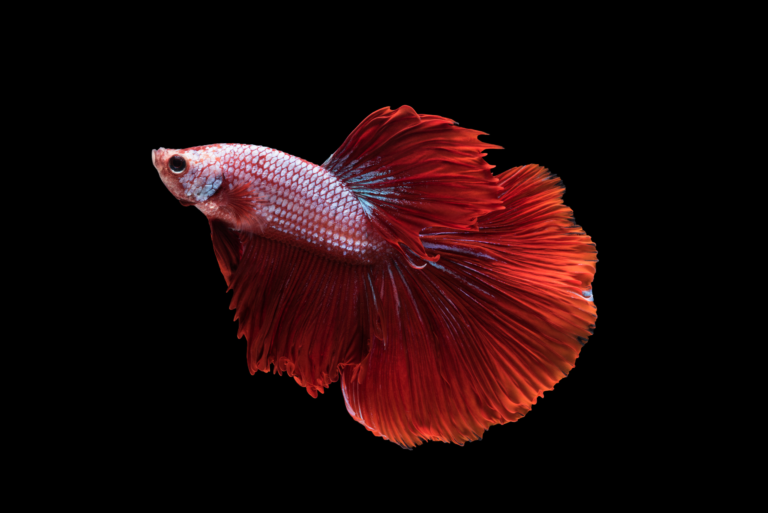Introduction
The Halfmoon Betta is one of the most striking and popular species in the Betta family, beloved by both beginner and seasoned fish enthusiasts. Known for its stunning tail that forms a perfect 180-degree “half-moon” shape, this fish has become a staple in many aquariums due to its beauty and unique behavior. In this article, we’ll dive into everything you need to know about the Halfmoon Betta—from its origins to the care tips that will keep your fish thriving.
1. What is a Halfmoon Betta?
The Halfmoon Betta is a variety of the Betta splendens species. Its most distinct feature is its broad, fan-shaped tail that spreads 180 degrees when fully flared, resembling a half-moon. This characteristic is what sets the Halfmoon Betta apart from other Betta varieties.
2. Origin and History of Halfmoon Betta
Halfmoon Bettas originated in Southeast Asia, particularly in Thailand, Cambodia, and Vietnam. Wild Bettas were initially bred for their fighting capabilities, but selective breeding has led to the development of different tail shapes and colors, including the Halfmoon variety. These fish gained popularity in the 1980s, and have since become one of the most sought-after Betta species.
3. Appearance of Halfmoon Betta
3.1 Tail and Fins
The tail of the Halfmoon Betta is its most distinguishing feature. When fully flared, it forms a perfect semi-circle, creating a dramatic and elegant display. The fins are often large and flowing, making the fish appear much larger than it actually is.
3.2 Colors
Halfmoon Bettas come in a wide variety of colors, from vibrant blues and reds to more subtle pastel hues. Selective breeding has also produced multi-colored varieties, with patterns that can be a mixture of solid, marble, or bi-color.
4. Behavior and Temperament
4.1 Aggression
Like most Bettas, the Halfmoon Betta is known for its aggressive behavior, especially toward other males. They are highly territorial, and placing two males in the same tank can lead to serious fights.
4.2 Activity Level
Halfmoon Bettas are active swimmers, often showing off their tails with pride. They enjoy exploring their environment and will frequently flare their fins as a display of dominance or curiosity.
5. Setting Up the Perfect Tank for Halfmoon Betta
5.1 Tank Size
While Bettas are often sold in small bowls, they thrive much better in larger environments. A tank of at least 5 gallons is recommended to provide them with enough space to swim freely and display their beautiful tails.
5.2 Water Conditions
Bettas are tropical fish, so they need warm water to stay healthy. Aim for a water temperature between 75°F and 80°F (24°C to 27°C). Additionally, the water should be clean, with a pH level between 6.5 and 7.5.
6. Feeding Halfmoon Bettas
6.1 Diet
Halfmoon Bettas are carnivorous, which means they thrive on a diet rich in protein. You can feed them high-quality Betta pellets, freeze-dried foods, and occasional live foods such as bloodworms or brine shrimp.
6.2 Feeding Schedule
To avoid overfeeding, offer food once or twice a day in small amounts. Bettas have a tendency to overeat, which can lead to digestive issues or bloating.
7. Common Health Problems and How to Prevent Them
7.1 Fin Rot
Fin rot is a common ailment in Bettas, especially those with long, flowing tails like the Halfmoon. To prevent fin rot, ensure that the tank water is clean and free of harmful bacteria.
7.2 Swim Bladder Disorder
This condition affects a fish’s buoyancy and is often caused by overfeeding or poor water quality. To prevent it, maintain a clean tank and avoid feeding your Betta too much at once.
8. Breeding Halfmoon Bettas
8.1 Mating Behavior
Breeding Halfmoon Bettas can be a rewarding yet challenging process. Males build bubble nests on the water’s surface, where the female will lay her eggs. Once the eggs are laid, the male takes on the role of protecting them until they hatch.
8.2 Raising Fry
Raising Betta fry requires careful attention, as the young fish are very delicate. You’ll need a separate breeding tank with clean, warm water and specialized food for the fry.
9. Lifespan of Halfmoon Betta
With proper care, Halfmoon Bettas can live up to 3 to 5 years. Their lifespan depends heavily on water conditions, diet, and overall care. Regular maintenance and attention will ensure your Betta lives a long and healthy life.
Conclusion
The Halfmoon Betta is undoubtedly one of the most stunning fish you can add to your aquarium. With its vibrant colors, elegant fins, and engaging personality, it’s easy to see why this fish is so popular among enthusiasts. Whether you’re a beginner or an experienced aquarist, with the right care, your Halfmoon Betta can become a beautiful and thriving centerpiece in your aquatic world.
FAQs
1. How can I tell if my Halfmoon Betta is healthy?
A healthy Halfmoon Betta will have vibrant colors, clear eyes, and an active swimming pattern. They should also eat regularly and display their fins frequently.
2. Can Halfmoon Bettas live with other fish?
Halfmoon Bettas can live with non-aggressive species, but it’s crucial to avoid housing them with other male Bettas due to their territorial nature.
3. How often should I clean my Betta’s tank?
It’s recommended to clean your Betta’s tank every week by doing a partial water change and removing any debris or leftover food.
4. What should I do if my Betta has fin rot?
Fin rot can be treated by improving water quality and using appropriate aquarium-safe medications. Quarantining the affected fish in a separate tank may also be necessary.
5. How can I enhance my Betta’s color?
A balanced diet, clean water, and the addition of aquarium lights can help bring out your Betta’s natural colors.
